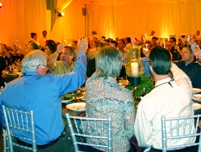
Elevating Safety Awareness
APA-The Engineered Wood Association has successfully revamped its safety program to generate enthusiasm and improve performance. Here's how it was done.
- By Jack Merry
- Jun 01, 2010
Like many industrial trade associations, APA—The Engineered Wood Association, a Tacoma, Wash.-based nonprofit comprised of U.S. and Canadian engineered wood product manufacturers, had for many years sponsored an annual safety awards competition to advance the safety consciousness of its members and to recognize those companies that lead their peers in safety performance.
But the competition had become a bit stale. The award categories were not particularly imaginative. Recognition of winners was limited. And the program was doing little to generate enthusiasm for the ultimate goal of saving lives and reducing injuries.
Enter Jeff Wagner and Dennis Hardman. Wagner, executive vice president of oriented strand board at Louisiana-Pacific Corporation, Nashville, Tenn., was elected to the APA Board of Trustees in 2006. He brought to the governing body a passion for mill safety and took his case to Dennis Hardman, who had recently been appointed APA’s president, the association’s top staff executive. Hardman, too, recognized that the association had both an opportunity and a duty to help improve the safe work environments of its members’ employees. And so the two embarked on an effort to revitalize the annual safety program.
 By way of background, APA was founded in 1933 as the Douglas Fir Plywood Association to advance the interests of the burgeoning Pacific Northwest softwood plywood industry. The name was changed in 1966 to American Plywood Association following the advent of southern pine plywood manufacturing in the U.S. Southeast. The name was changed again in 1994 to APA—The Engineered Wood Association in order to better reflect the broadening product mix and geographic range of its membership. APA, as it is commonly called today, represents approximately 150 engineered wood product mills in the United States and Canada. Member products, in addition to plywood, now include oriented strand board (OSB), laminated veneer lumber (LVL), glued-laminated timber (glulam), and wood I-joists. The organization’s primary functions are quality auditing and testing, product application research, and market support and development.
By way of background, APA was founded in 1933 as the Douglas Fir Plywood Association to advance the interests of the burgeoning Pacific Northwest softwood plywood industry. The name was changed in 1966 to American Plywood Association following the advent of southern pine plywood manufacturing in the U.S. Southeast. The name was changed again in 1994 to APA—The Engineered Wood Association in order to better reflect the broadening product mix and geographic range of its membership. APA, as it is commonly called today, represents approximately 150 engineered wood product mills in the United States and Canada. Member products, in addition to plywood, now include oriented strand board (OSB), laminated veneer lumber (LVL), glued-laminated timber (glulam), and wood I-joists. The organization’s primary functions are quality auditing and testing, product application research, and market support and development.
Launched in 1982, the APA safety awards program had remained largely unchanged for the ensuing quarter century. Awards were given to mills with the lowest recordable injury and illness incidence rates based on guidelines established by OSHA. Both annual and three-year average awards were presented. Canadian members became eligible in 2001 after differences in recordable incidence criteria used by OSHA and the Canadian Workers Compensation Board (WCB) were reconciled.
Historically, wood products manufacturing has been a hazardous industry within the generally hazardous manufacturing sector. However, incidence rates can vary among different segments of the wood products industry. And the rates in modern engineered wood products manufacturing plants have shown marked improvement in recent years. In 1994, for example, the average Time Incidence Rate (TIR) of all mills (both member and non-member) submitting data to APA was 6.74. The trend line since then has been impressively downward, with the industry average TIR totaling less than 2.0 in both 2007 and 2008 — a 70 percent improvement.
With the industry apparently already headed in the right direction, why the push to shake things up? "You can't rest on last year's performance," Wagner said. "The existing program was a good one and had served an important purpose. But the industry can do better, and should do better. The goal always should be continuous improvement."
The first action in support of that goal was to form a Safety Awards Task Group (since elevated to a standing committee) comprised of several APA member company safety professionals. Their mandate was simple: review the existing program and make it better. Wagner, who has since become chairman of APA's Board of Trustees, assumed leadership of the task group while Hardman and key staff members serve as staff advisers and program managers.
APA Safety Award Categories
Participating member mills are grouped into Division I (less than 400,000 hours worked in the year) or Division II (400,000 or more hours worked in the year). To be eligible for an APA award, a member mill must meet the following criteria:
- The mill must have operated for at least three months during the calendar year.
- The mill must have had no facility-related fatality, including fatalities of outside service providers while working at the facility.
- The mill must have a WIR ranking among the best 50 percent of all mills that participate in the APA Safety Survey.
Divisional Awards
The following awards are presented individually to both Division I and Division II mills:
- Annual Safety and Health Honor Roll, presented to the three mills in each Division with the best Weighted Incidence Rate (WIR)
- Three-Year Safety Award, presented to the mill in each Division with the best average WIR over the previous three years.
- Safety Improvement Award, presented to the mill in each Division with three consecutive years of improving WIR and the largest percentage improvement between the first and third year.
Innovation in Safety Award
Presented to the mill, group of mills, or company judged by the APA Safety Awards Committee to have made the most significant advancement in mill safety and health operational excellence. The advancement must be an innovative/novel solution proven to reduce occupational injuries or illnesses and/or improve safety awareness on or off the job, and it must be applicable across the industry.
Safest Company Awards
The Safest Company Awards are based on the best average WIR for the company's member mills. One award is presented to a company with three or fewer mills, another award to a company with four or more mills.
Incident Free Honor Society
Any participating mill that achieves a 0.00 WIR for the year is recognized as a member of the Incident Free Honor Society.
The group settled on three main objectives: Make the APA program the premier safety awards program in the industry, encourage the sharing of best practices as a means to improve the industry's safety culture and programs, and, most importantly, improve the industry's overall safety performance.
Several program changes were reviewed and adopted. A severity WIR, for example, was developed to provide a more meaningful measure of a mill's safety performance. After considering several approaches, a weighted formula was developed as follows: Mill WIR = (R = 5 x RW = 10 x LT) x 200,000/mill hours, where WIR equals the mill's weighted incidence rate for the year, R equals recordable incidents, RW equals restricted work incidents, and LT equals lost time incidents.
Several new award categories also were created to generate enthusiasm and to facilitate the sharing of best practices. Among these was an Innovation in Safety Award presented to a mill, group of mills, or an entire company judged by the Safety Committee to have made a significant advancement in occupational safety and health excellence. Criteria for the award include demonstrating the innovation reduced occupational injuries or illnesses and the technique or program be applied across the industry.
The first Innovation Award was presented to RoyOMartin, Alexandria, La., for its Winning with Wellness program. Since launching the program in 2001, the company has seen its TIR decline from 4.87 to 1.13, annual worker's compensation claims dropped from 64 to 25, and the growth in the cost of medical/pharmaceutical claims has been held to 1-2 percent per year compared with the national average of 10 percent.
Nine other Innovation in Safety entries were submitted, all of which were then posted on APA's website (www.apawood.org) under a newly created Safety and Health section for sharing with the industry. Entries ranged from the simple to the creative. One mill, for example, designed, built, and installed a log-handling device that reduced worker exposure to a hazardous log conveyance area. Another mill required the use of highly visible green vests in product finishing and warehouse operations to reduce the risk of collisions between forklifts and employees on foot. And a company developed large "safety status boards" for posting safety performance indicators, including recordable incidents, near misses, safety goal progress, etc. in multiple locations.
Increased Recognition
Another major change to the program was recognition of winners. Typically in the past, award-winning mill managers and/or their bosses were treated to an invitation-only awards luncheon or dinner during the APA annual meeting. That was appreciated by the winners, but it did little to convey the magnitude of their achievements or the importance of mill safety generally to the hundreds of others who attend the annual meeting.
 Under the new program, recognition of the winning mills and companies is now the centerpiece of a Chairman's Dinner, a function attended by virtually everyone at the APA annual meeting -—association members, industry suppliers, other stakeholders, and invited guests. As a result, both the achievements of the winning mills and companies and the importance of mill safety as an industry priority have been significantly elevated. Award plaques also are personally presented by President Hardman and/or other management staff to mill personnel at the winning mills, a gesture designed to reinforce the both the prestige of the awards and the importance of mill safety efforts.
Under the new program, recognition of the winning mills and companies is now the centerpiece of a Chairman's Dinner, a function attended by virtually everyone at the APA annual meeting -—association members, industry suppliers, other stakeholders, and invited guests. As a result, both the achievements of the winning mills and companies and the importance of mill safety as an industry priority have been significantly elevated. Award plaques also are personally presented by President Hardman and/or other management staff to mill personnel at the winning mills, a gesture designed to reinforce the both the prestige of the awards and the importance of mill safety efforts.
APA attempts to collect safety data from all structural engineered wood product mills in the United States and Canada -- whether they are APA members or not -- to provide the most comprehensive annual composite measure of industry safety performance. Eligibility for safety awards, however, is now restricted to APA members, based on the judgment of the APA Board of Trustees that the prestige of the awards should be bestowed only on mills and companies that financially support the APA program.
Feedback from the membership on the program changes was favorable and supportive. While presiding over the awards ceremony during APA's annual meeting in Florida last fall, Wagner made it clear that his passion for continuous safety performance improvement continues to run strong, however. He issued three new challenges to the industry. He called for an industry TIR target of 1 by 2011, half the rate recorded in 2008. He set a goal of 100 percent member participation in the safety program, up from the 75 percent in 2008. And he challenged APA's membership to double the number of Innovation in Safety Award entries, from ten to 20.
The results of the latest competition, just in, show both progress and room for improvement. Association member participation rose to 78 percent, and the number of Innovations entries more than doubled, from 10 to 24. However, the 2009 industry Weighted Incident Rate was up slightly from 2008 -— 10.64 versus 10.02.
The Safety Committee, in response, has embarked on several new initiatives to help in meeting the ambitious goals set by Chairman Wagner. Among them are plans for conducting two all-day industry safety workshops per year, the first of which will be held this fall in conjunction with the APA annual meeting in Tucson; developing a database of industry safety professionals for more effective sharing of best practices; and expanding the safety and health section of the APA website to make it a more useful industry safety information clearinghouse and networking tool.